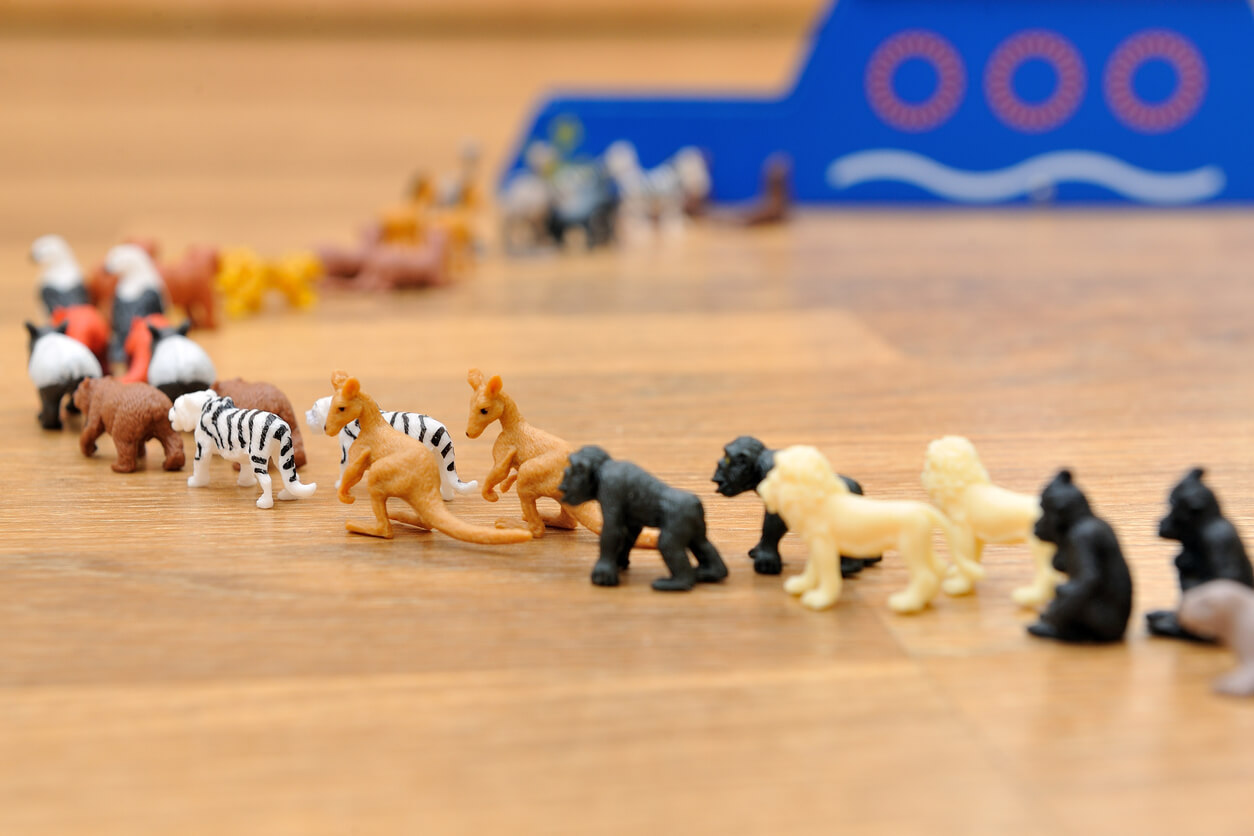Why Does My Child Line Up Their Toys?

Have you noticed that your child will line up their toys when playing and have you wondered why they do it? Today we want to talk a little more about this topic and tell you what their behavior can mean.
There are children who line up their toys as a form of play or to identify and discriminate them. This activity usually appears between the ages of two and three, when little ones acquire the ability to do it, as mentioned by the psychologist Jerome Seymour Bruner.
But, are there other issues or motivations that lead children to line up their toys? If you want to know, keep reading the following article.
Why do children line up their toys and what does it mean?
Many children line up their toys as they play during a certain period of their lives. This is completely normal in the vast majority of infants and corresponds to an expected stage of development.
Although in principle, there’s nothing to worry about, it’s common knowledge that this habit is part of the range of typical manifestations of autism spectrum disorder (ASD).
How can you know if it’s a normal or pathological trait of development? In the following paragraphs, we’ll explain all of this to you in detail. But first, let’s see the reasons why a child with typical development (that is, expected) may line up their toys when playing.

1. To classify or categorize their objects
During the first years of life, the different types of intelligence are developed, among which is the logical-mathematical. For this reason, it’s completely normal for two and three-year-olds to classify their toys according to the characteristics they share with each other. For example, color, size, or shape, among other aspects.
It’s a way of grouping, categorizing, or putting together sets.
2. By their own logic
Sometimes the toys are lined up without any apparent criteria for the adult. However, the child may have their own logic and follow it when organizing their objects. For example, they may mimic what they see on the road when they go for a walk or park cars on the sidewalk.
We have to keep an open mind and not take a particular way of playing for granted. Little ones are very creative and establish their own rules and criteria.
What may seem meaningless to you may be full of logic to them.
3. As a form of research or exploration
Play is a very important part of children’s development. Through it, they discover and explore the world. Therefore, lining up toys can be a way of exploring their objects and their own criteria in their own way.
Also, they can create stories through these alignments and exercise symbolic play. For example, imitate the checkout line at the supermarket or the animals climbing into Noah’s Ark.
“My son lines up his toys, can he have autism?”
As we’ve said before, most of the time, the habit of lining up toys is part of the normal development of the child. However, this habit can also exist in children with certain developmental pathologies, such as autism spectrum disorder (ASD).
Children with ASD tend to manipulate toys in a repetitive and non-functional way. Likewise, their play is never symbolic.
It should be noted that in order to talk about autism, it’s not enough to say that those who have it line up their toys. To determine this diagnosis, the evaluation of a specialist is necessary.
In addition to this symptom, children with ASD show difficulties in communication and social interaction, they don’t look you in the eye when you speak to them, and they tend to maintain restrictive interests, among other aspects.
When is it normal and when is it a red flag for children to line up their toys?
As we’ve seen in the previous paragraphs, it’s totally normal for some children to line up their toys while they play, as it’s part of the development of their game. So when should we worry?
- When this type of game is accompanied by difficulties in communication and social interaction.
- If the child only plays that way in a repetitive and very basic way (with no apparent purpose).
- The child is unable to play other games and becomes obsessed with the same activity or shows strong resistance to change.
- Doesn’t use symbolic play and doesn’t want to interact with anyone.
These are some of the aspects that can make us suspect that there may be something more behind the behavior. In that case, it’s important to make an appointment with a specialist to make a proper evaluation of the child.

Children who line up their toys
As we’ve seen in this article, the lining up of toys can be a completely normal behavior in children. Throughout the development play, changes occur and between the ages of two and three, little ones learn to categorize and discriminate between objects. Therefore, they use this ability very frequently, even in their playful activities.
Now, if we observe this behavior in the context of symptoms that make us suspect a possible case of ASD, the most important thing is to inform your pediatrician so that they request the appropriate evaluation.
“Play is a powerful invention of nature. The instrument of play, a combination of curiosity and pleasure, is the most powerful weapon for learning.”
-Francisco Mora, neuroeducator-
Have you noticed that your child will line up their toys when playing and have you wondered why they do it? Today we want to talk a little more about this topic and tell you what their behavior can mean.
There are children who line up their toys as a form of play or to identify and discriminate them. This activity usually appears between the ages of two and three, when little ones acquire the ability to do it, as mentioned by the psychologist Jerome Seymour Bruner.
But, are there other issues or motivations that lead children to line up their toys? If you want to know, keep reading the following article.
Why do children line up their toys and what does it mean?
Many children line up their toys as they play during a certain period of their lives. This is completely normal in the vast majority of infants and corresponds to an expected stage of development.
Although in principle, there’s nothing to worry about, it’s common knowledge that this habit is part of the range of typical manifestations of autism spectrum disorder (ASD).
How can you know if it’s a normal or pathological trait of development? In the following paragraphs, we’ll explain all of this to you in detail. But first, let’s see the reasons why a child with typical development (that is, expected) may line up their toys when playing.

1. To classify or categorize their objects
During the first years of life, the different types of intelligence are developed, among which is the logical-mathematical. For this reason, it’s completely normal for two and three-year-olds to classify their toys according to the characteristics they share with each other. For example, color, size, or shape, among other aspects.
It’s a way of grouping, categorizing, or putting together sets.
2. By their own logic
Sometimes the toys are lined up without any apparent criteria for the adult. However, the child may have their own logic and follow it when organizing their objects. For example, they may mimic what they see on the road when they go for a walk or park cars on the sidewalk.
We have to keep an open mind and not take a particular way of playing for granted. Little ones are very creative and establish their own rules and criteria.
What may seem meaningless to you may be full of logic to them.
3. As a form of research or exploration
Play is a very important part of children’s development. Through it, they discover and explore the world. Therefore, lining up toys can be a way of exploring their objects and their own criteria in their own way.
Also, they can create stories through these alignments and exercise symbolic play. For example, imitate the checkout line at the supermarket or the animals climbing into Noah’s Ark.
“My son lines up his toys, can he have autism?”
As we’ve said before, most of the time, the habit of lining up toys is part of the normal development of the child. However, this habit can also exist in children with certain developmental pathologies, such as autism spectrum disorder (ASD).
Children with ASD tend to manipulate toys in a repetitive and non-functional way. Likewise, their play is never symbolic.
It should be noted that in order to talk about autism, it’s not enough to say that those who have it line up their toys. To determine this diagnosis, the evaluation of a specialist is necessary.
In addition to this symptom, children with ASD show difficulties in communication and social interaction, they don’t look you in the eye when you speak to them, and they tend to maintain restrictive interests, among other aspects.
When is it normal and when is it a red flag for children to line up their toys?
As we’ve seen in the previous paragraphs, it’s totally normal for some children to line up their toys while they play, as it’s part of the development of their game. So when should we worry?
- When this type of game is accompanied by difficulties in communication and social interaction.
- If the child only plays that way in a repetitive and very basic way (with no apparent purpose).
- The child is unable to play other games and becomes obsessed with the same activity or shows strong resistance to change.
- Doesn’t use symbolic play and doesn’t want to interact with anyone.
These are some of the aspects that can make us suspect that there may be something more behind the behavior. In that case, it’s important to make an appointment with a specialist to make a proper evaluation of the child.

Children who line up their toys
As we’ve seen in this article, the lining up of toys can be a completely normal behavior in children. Throughout the development play, changes occur and between the ages of two and three, little ones learn to categorize and discriminate between objects. Therefore, they use this ability very frequently, even in their playful activities.
Now, if we observe this behavior in the context of symptoms that make us suspect a possible case of ASD, the most important thing is to inform your pediatrician so that they request the appropriate evaluation.
“Play is a powerful invention of nature. The instrument of play, a combination of curiosity and pleasure, is the most powerful weapon for learning.”
-Francisco Mora, neuroeducator-
All cited sources were thoroughly reviewed by our team to ensure their quality, reliability, currency, and validity. The bibliography of this article was considered reliable and of academic or scientific accuracy.
- Zamorano, M. M., Abad, M. E. M., Hernández, M. J. H., Herrera, C. Q., & de la Fuente, E. P. (2019). La importancia del juego en los niños. Canarias pediatrica, 43(1), 31-35. En internet: https://dialnet.unirioja.es/servlet/articulo?codigo=7186932
- Abad, J., & Ruiz de Velasco, A. (2011). El juego simbólico. Aula Infantil. En internet: https://masteratenciontemprana.org/wp-content/uploads/2019/04/El-juego-simbolico-javier-abad.pdf
- Uribe Rivera, G.M. (2016) DESARROLLO DE LA INTELIGENCIA LÓGICO MATEMÁTICA MEDIANTE
EL JUEGO EN NIÑOS Y NIÑAS DEL GRADO JARDÍN EN LA INSTITUCIÓN
EDUCATIVA GIMNASIO DOMINGO SAVIO. LICENCIATURA EN EDUCACIÓN PREESCOLAR. Facultad de Educación, Universidad Santo Tomás. Colombia. Disponible en: https://repository.usta.edu.co/handle/11634/9744
This text is provided for informational purposes only and does not replace consultation with a professional. If in doubt, consult your specialist.








